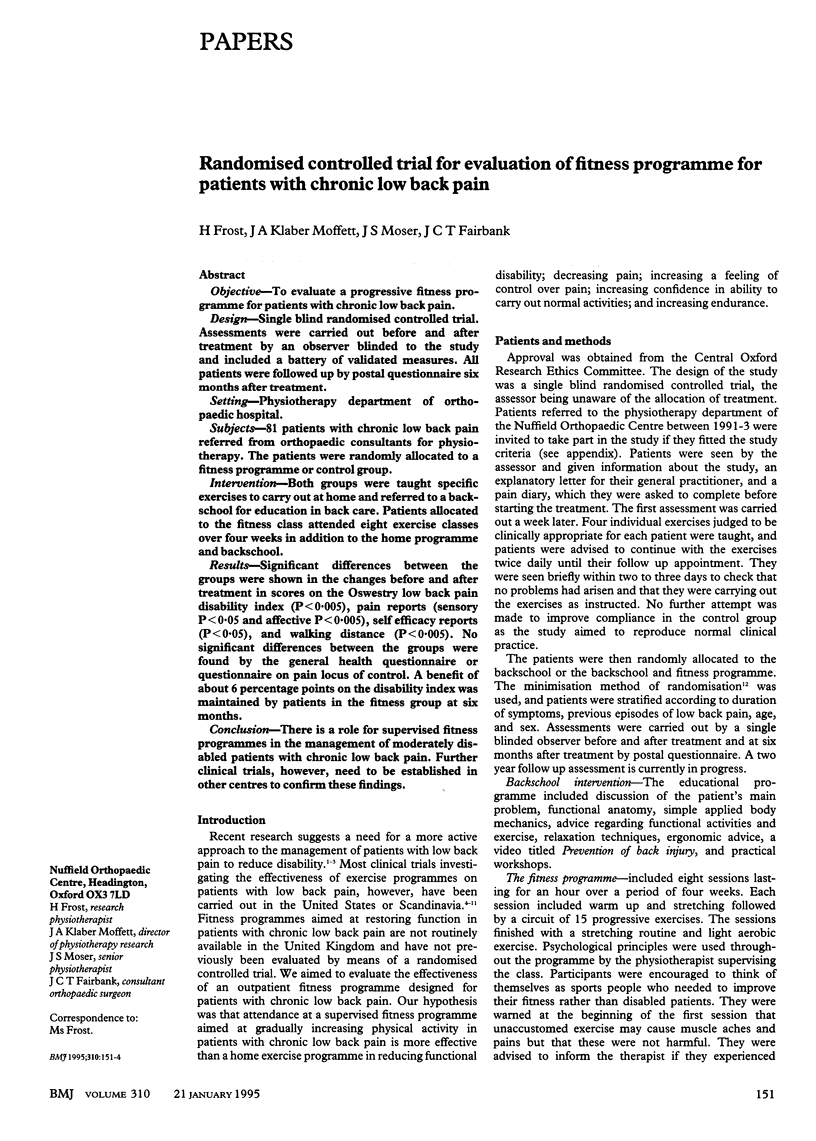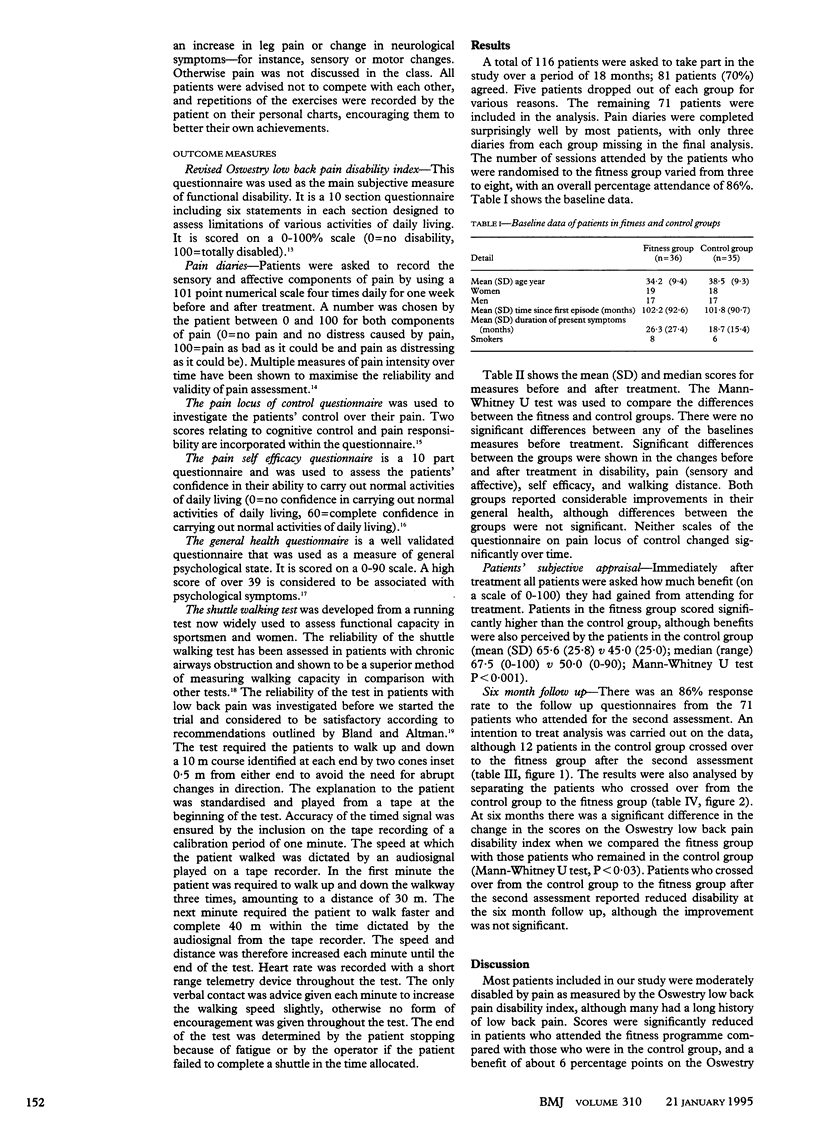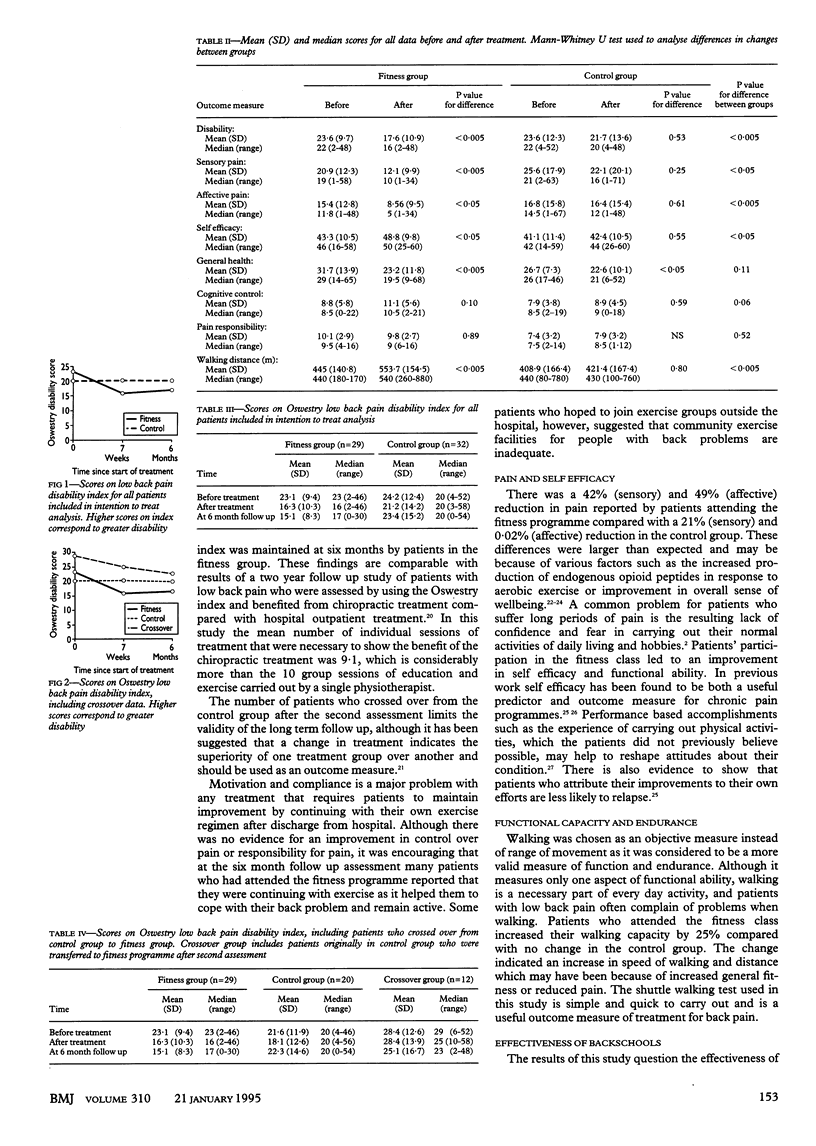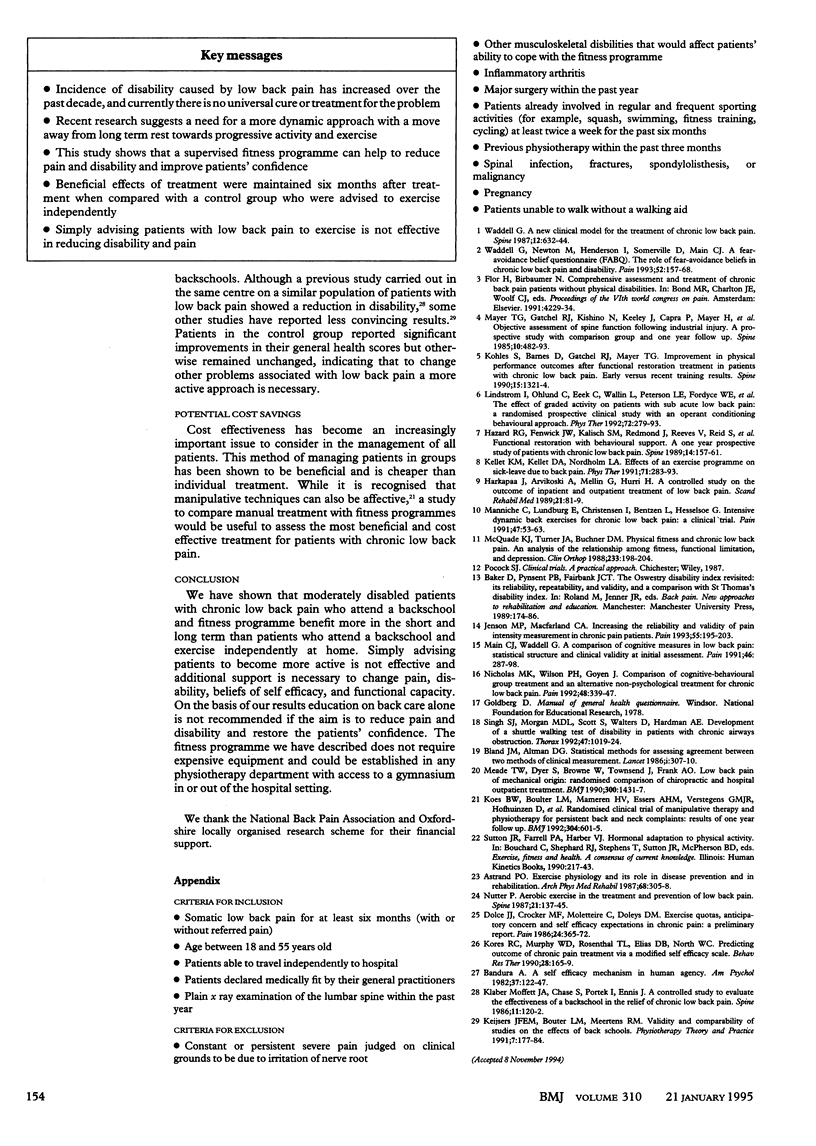Abstract
OBJECTIVE--To evaluate a progressive fitness programme for patients with chronic low back pain. DESIGN--Single blind randomised controlled trial. Assessments were carried out before and after treatment by an observer blinded to the study and included a battery of validated measures. All patients were followed up by postal questionnaire six months after treatment. SETTING--Physiotherapy department of orthopaedic hospital. SUBJECTS--81 patients with chronic low back pain referred from orthopaedic consultants for physiotherapy. The patients were randomly allocated to a fitness programme or control group. INTERVENTION--Both groups were taught specific exercises to carry out at home and referred to a back-school for education in back care. Patients allocated to the fitness class attended eight exercise classes over four weeks in addition to the home programme and backschool. RESULTS--Significant differences between the groups were shown in the changes before and after treatment in scores on the Oswestry low back pain disability index (P < 0.005), pain reports (sensory P < 0.05 and affective P < 0.005), self efficacy reports (P < 0.05), and walking distance (P < 0.005). No significant differences between the groups were found by the general health questionnaire or questionnaire on pain locus of control. A benefit of about 6 percentage points on the disability index was maintained by patients in the fitness group at six months. CONCLUSION--There is a role for supervised fitness programmes in the management of moderately disabled patients with chronic low back pain. Further clinical trials, however, need to be established in other centres to confirm these findings.
Full text
PDF



Selected References
These references are in PubMed. This may not be the complete list of references from this article.
- Astrand P. O. Exercise physiology and its role in disease prevention and in rehabilitation. Arch Phys Med Rehabil. 1987 May;68(5 Pt 1):305–309. [PubMed] [Google Scholar]
- Bland J. M., Altman D. G. Statistical methods for assessing agreement between two methods of clinical measurement. Lancet. 1986 Feb 8;1(8476):307–310. [PubMed] [Google Scholar]
- Dolce J. J., Crocker M. F., Moletteire C., Doleys D. M. Exercise quotas, anticipatory concern and self-efficacy expectancies in chronic pain: a preliminary report. Pain. 1986 Mar;24(3):365–372. doi: 10.1016/0304-3959(86)90122-3. [DOI] [PubMed] [Google Scholar]
- Hazard R. G., Fenwick J. W., Kalisch S. M., Redmond J., Reeves V., Reid S., Frymoyer J. W. Functional restoration with behavioral support. A one-year prospective study of patients with chronic low-back pain. Spine (Phila Pa 1976) 1989 Feb;14(2):157–161. [PubMed] [Google Scholar]
- Härkäpä K., Järvikoski A., Mellin G., Hurri H. A controlled study on the outcome of inpatient and outpatient treatment of low back pain. Part I. Pain, disability, compliance, and reported treatment benefits three months after treatment. Scand J Rehabil Med. 1989;21(2):81–89. [PubMed] [Google Scholar]
- Jensen M. P., McFarland C. A. Increasing the reliability and validity of pain intensity measurement in chronic pain patients. Pain. 1993 Nov;55(2):195–203. doi: 10.1016/0304-3959(93)90148-I. [DOI] [PubMed] [Google Scholar]
- Kellett K. M., Kellett D. A., Nordholm L. A. Effects of an exercise program on sick leave due to back pain. Phys Ther. 1991 Apr;71(4):283–293. doi: 10.1093/ptj/71.4.283. [DOI] [PubMed] [Google Scholar]
- Klaber Moffett J. A., Chase S. M., Portek I., Ennis J. R. A controlled, prospective study to evaluate the effectiveness of a back school in the relief of chronic low back pain. Spine (Phila Pa 1976) 1986 Mar;11(2):120–122. doi: 10.1097/00007632-198603000-00003. [DOI] [PubMed] [Google Scholar]
- Koes B. W., Bouter L. M., van Mameren H., Essers A. H., Verstegen G. M., Hofhuizen D. M., Houben J. P., Knipschild P. G. Randomised clinical trial of manipulative therapy and physiotherapy for persistent back and neck complaints: results of one year follow up. BMJ. 1992 Mar 7;304(6827):601–605. doi: 10.1136/bmj.304.6827.601. [DOI] [PMC free article] [PubMed] [Google Scholar]
- Kohles S., Barnes D., Gatchel R. J., Mayer T. G. Improved physical performance outcomes after functional restoration treatment in patients with chronic low-back pain. Early versus recent training results. Spine (Phila Pa 1976) 1990 Dec;15(12):1321–1324. doi: 10.1097/00007632-199012000-00016. [DOI] [PubMed] [Google Scholar]
- Kores R. C., Murphy W. D., Rosenthal T. L., Elias D. B., North W. C. Predicting outcome of chronic pain treatment via a modified self-efficacy scale. Behav Res Ther. 1990;28(2):165–169. doi: 10.1016/0005-7967(90)90029-i. [DOI] [PubMed] [Google Scholar]
- Lindström I., Ohlund C., Eek C., Wallin L., Peterson L. E., Fordyce W. E., Nachemson A. L. The effect of graded activity on patients with subacute low back pain: a randomized prospective clinical study with an operant-conditioning behavioral approach. Phys Ther. 1992 Apr;72(4):279–293. doi: 10.1093/ptj/72.4.279. [DOI] [PubMed] [Google Scholar]
- Main C. J., Waddell G. A comparison of cognitive measures in low back pain: statistical structure and clinical validity at initial assessment. Pain. 1991 Sep;46(3):287–298. doi: 10.1016/0304-3959(91)90112-B. [DOI] [PubMed] [Google Scholar]
- Manniche C., Lundberg E., Christensen I., Bentzen L., Hesselsøe G. Intensive dynamic back exercises for chronic low back pain: a clinical trial. Pain. 1991 Oct;47(1):53–63. doi: 10.1016/0304-3959(91)90011-L. [DOI] [PubMed] [Google Scholar]
- Mayer T. G., Gatchel R. J., Kishino N., Keeley J., Capra P., Mayer H., Barnett J., Mooney V. Objective assessment of spine function following industrial injury. A prospective study with comparison group and one-year follow-up. Spine (Phila Pa 1976) 1985 Jul-Aug;10(6):482–493. doi: 10.1097/00007632-198507000-00002. [DOI] [PubMed] [Google Scholar]
- McQuade K. J., Turner J. A., Buchner D. M. Physical fitness and chronic low back pain. An analysis of the relationships among fitness, functional limitations, and depression. Clin Orthop Relat Res. 1988 Aug;(233):198–204. [PubMed] [Google Scholar]
- Meade T. W., Dyer S., Browne W., Townsend J., Frank A. O. Low back pain of mechanical origin: randomised comparison of chiropractic and hospital outpatient treatment. BMJ. 1990 Jun 2;300(6737):1431–1437. doi: 10.1136/bmj.300.6737.1431. [DOI] [PMC free article] [PubMed] [Google Scholar]
- Nicholas M. K., Wilson P. H., Goyen J. Comparison of cognitive-behavioral group treatment and an alternative non-psychological treatment for chronic low back pain. Pain. 1992 Mar;48(3):339–347. doi: 10.1016/0304-3959(92)90082-M. [DOI] [PubMed] [Google Scholar]
- Singh S. J., Morgan M. D., Scott S., Walters D., Hardman A. E. Development of a shuttle walking test of disability in patients with chronic airways obstruction. Thorax. 1992 Dec;47(12):1019–1024. doi: 10.1136/thx.47.12.1019. [DOI] [PMC free article] [PubMed] [Google Scholar]
- Waddell G. 1987 Volvo award in clinical sciences. A new clinical model for the treatment of low-back pain. Spine (Phila Pa 1976) 1987 Sep;12(7):632–644. doi: 10.1097/00007632-198709000-00002. [DOI] [PubMed] [Google Scholar]
- Waddell G., Newton M., Henderson I., Somerville D., Main C. J. A Fear-Avoidance Beliefs Questionnaire (FABQ) and the role of fear-avoidance beliefs in chronic low back pain and disability. Pain. 1993 Feb;52(2):157–168. doi: 10.1016/0304-3959(93)90127-B. [DOI] [PubMed] [Google Scholar]


